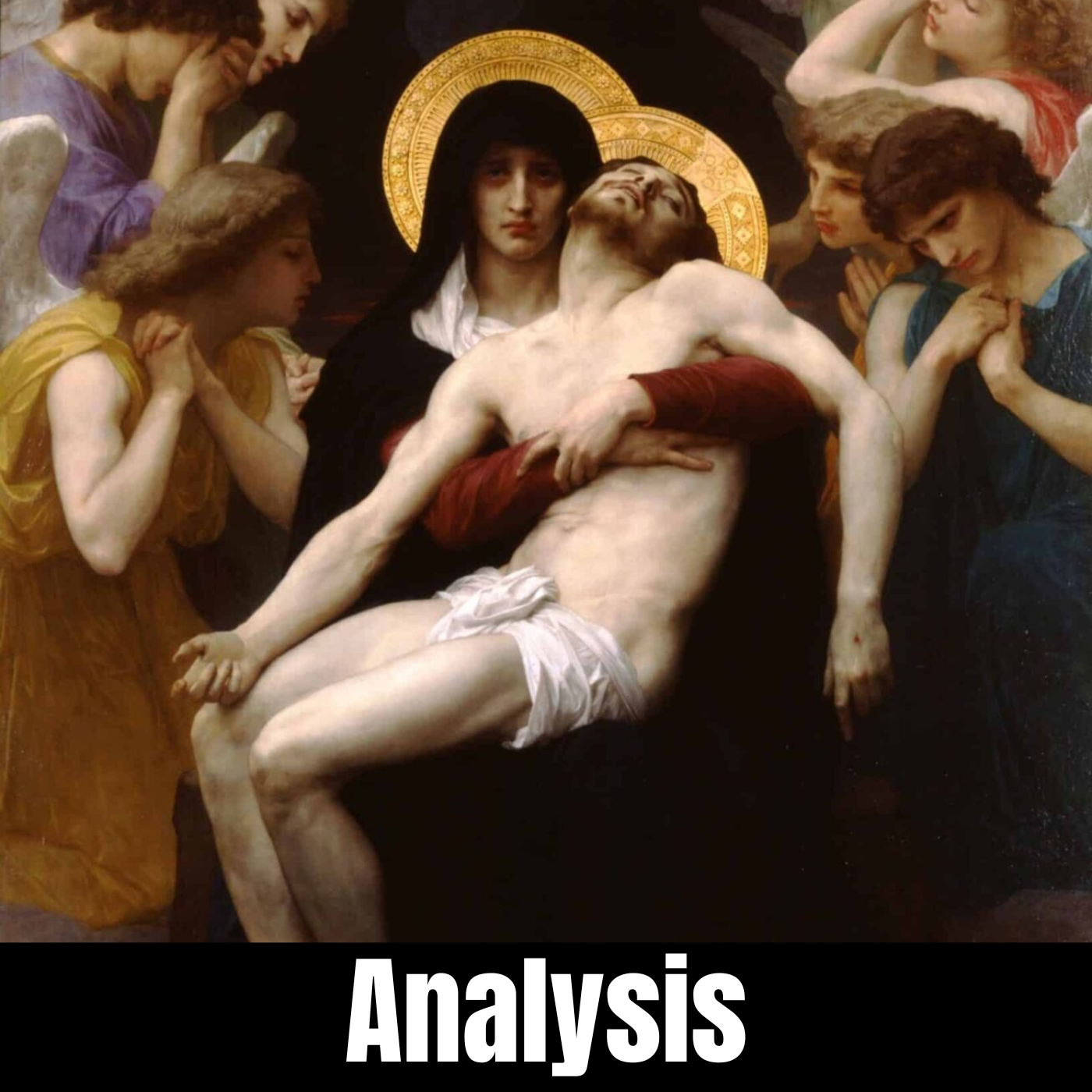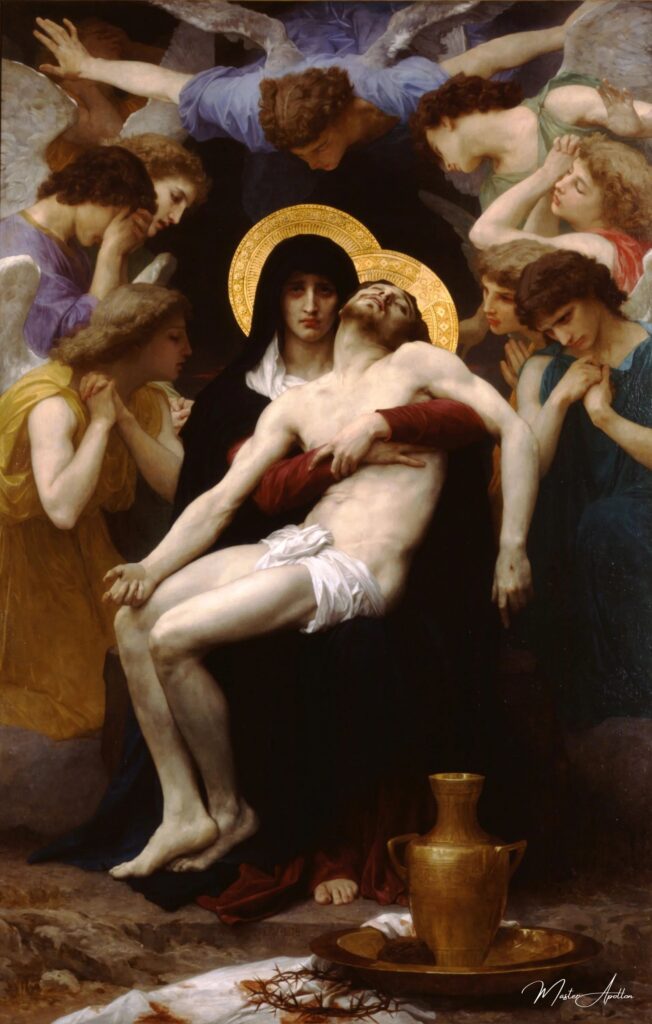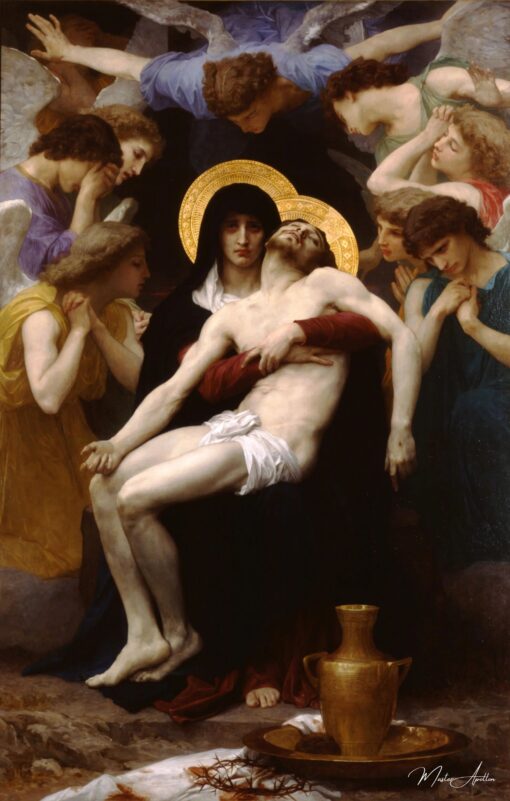Your cart is currently empty!
Pietà – William Bouguereau


Pietà – William Bouguereau
This oil painting reproduction of Pietà by William Bouguereau is a stunning masterpiece that captures the essence of sorrow and compassion in a truly captivating way. Crafted with the highest quality materials and meticulous attention to detail, this reproduction exudes elegance and authenticity that will elevate any space it graces.
The craftsmanship of this piece is unparalleled, with each…
William-Adolphe Bouguereau’s Pietà (1876): A Masterpiece of Grief, Devotion, and Symbolism
William-Adolphe Bouguereau, one of the most celebrated French academic painters of the 19th century, was known for his technical precision, polished classical style, and emotional depth. Among his many renowned works, Pietà (1876) stands out as a particularly poignant and personal masterpiece. Though it depicts a familiar religious subject—the Virgin Mary cradling the body of her dead son, Jesus Christ—Pietà goes beyond mere representation. It serves as a deeply personal expression of the artist’s grief following the loss of his own son, Georges, making it one of Bouguereau’s most emotionally charged and symbolically layered works.
The Traditional Pietà Scene
The theme of the Pietà, showing the Virgin Mary mourning over the body of the crucified Christ, has been a central subject in Christian art for centuries. This motif was popularized during the Renaissance, with Michelangelo’s Pietà (1498–1499) as one of the most iconic interpretations. The emotional intensity of the subject—capturing a mother’s sorrow and the ultimate sacrifice of Christ for humanity—has made it a timeless theme in Western religious art.
Bouguereau’s Pietà (1876) adheres to this tradition, presenting the Virgin Mary seated and holding the lifeless body of Jesus, draped over her lap in a position of serene yet devastating grief. The figures are arranged in a pyramidal composition, a structure often used to emphasize stability and divinity in religious paintings. Mary’s expression is solemn but composed, and her gaze is turned downwards, lost in the sorrow of the moment. Jesus’ body, pale and limp, contrasts against the darker, more somber tones of the background, emphasizing the finality of death.
However, Bouguereau’s Pietà is not just a conventional depiction of the biblical event. This painting bears the weight of the artist’s personal mourning and loss.
A Personal Memorial: Grieving for Georges
Bouguereau painted Pietà in the wake of the death of his sixteen-year-old son, Georges. On July 19, 1865, Georges died, leaving the artist and his family devastated. This personal tragedy profoundly affected Bouguereau and informed his approach to Pietà, transforming it from a traditional religious scene into a heartfelt memorial to his beloved son.
An inscription on an urn in the painting reads: “In memory of my beloved son, Georges, on 19 July 1865.” This explicit reference to Bouguereau’s loss infuses the artwork with a sense of personal grief, making it not just a religious painting but a tribute to his son. Bouguereau, who had always been deeply devout, found solace in Christian iconography, and in Pietà, his mourning for Georges is channeled through the Virgin Mary’s mourning for her son. In this way, the painting becomes a universal expression of loss, grief, and faith.
Angelic Presence: A Circle of Comfort
Adding to the emotional complexity of Pietà are the eight angels that surround the central figures of Mary and Jesus. These angels, dressed in flowing robes of different colors, create a visual harmony within the painting while also contributing to its symbolic meaning.
The angels are arranged in a circular formation, almost enclosing Mary and Jesus in a protective, heavenly embrace. Their presence elevates the painting from a moment of human sorrow to one of divine grace and eternal comfort. The angels seem to represent a bridge between heaven and earth, reinforcing the notion that Christ’s sacrifice was not only for humanity but also a part of the divine plan.
The diversity in the angels’ robes has led to an interesting interpretation. Some scholars suggest that the different colors symbolize a rainbow, evoking the biblical story of Noah’s Ark. According to the story, after the floodwaters subsided, God placed a rainbow in the sky as a sign of His promise that He would never again destroy the earth with a flood and that a new covenant had been established between God and humanity. In this context, the rainbow in Pietà could symbolize the end of Jesus’ earthly suffering and the beginning of a new covenant between God and humankind—a reunion of the divine and the mortal. While this interpretation is compelling, it remains a topic of debate, and further scholarly research is needed to fully validate the rainbow symbolism within the painting.
Symbolism of Sacrifice and Rebirth
At the heart of Bouguereau’s Pietà lies the symbolism of sacrifice, grief, and eventual rebirth. Jesus’ death and resurrection are central tenets of Christian theology, and in the painting, this theme is presented with both personal and universal significance.
For Bouguereau, the loss of his son likely felt like an unbearable sacrifice, much like the Virgin Mary’s loss of Jesus. However, just as Jesus’ death led to his resurrection and the salvation of mankind, Bouguereau may have found solace in the belief that his son, Georges, too, would experience eternal life in the afterlife. The angels surrounding the Virgin and Christ, as well as the rainbow-like colors of their robes, suggest that although death is painful, it is not the end. There is a promise of hope and renewal, whether in the Christian belief in the resurrection or the enduring legacy of loved ones.
A Masterpiece Held at the Dallas Museum of Art
Pietà (1876) is currently housed in the collection of the Dallas Museum of Art, where it stands as a testament to Bouguereau’s technical mastery and emotional depth. The painting’s rich symbolism, personal connection to the artist’s life, and its representation of a universal theme of grief and hope make it one of Bouguereau’s most significant works. It is a piece that invites viewers to reflect not only on the religious themes it presents but also on the nature of human suffering, love, and the promise of transcendence.
Conclusion: Bouguereau’s Pietà as an Expression of Universal Grief
In Pietà (1876), William-Adolphe Bouguereau achieved a remarkable synthesis of personal grief and religious devotion. While the painting depicts the traditional Christian narrative of the Virgin Mary mourning the death of her son, Jesus, it also serves as a memorial to Bouguereau’s own son, Georges. The inscription on the urn within the painting makes this connection explicit, while the angelic figures and their rainbow-like robes add layers of symbolism that transcend the specific event depicted.
Ultimately, Pietà is a painting about loss—both personal and universal—and the hope that lies beyond it. Bouguereau’s technical brilliance and emotional sensitivity come together to create a masterpiece that resonates with viewers on multiple levels, inviting them to find their own meanings in the sorrow and symbolism that pervades the work. It is a painting that speaks not only to the heart of Christian faith but also to the shared human experience of mourning, memory, and the search for meaning in the face of death.
William Bouguereau
William-Adolphe Bouguereau was a renowned French academic painter, celebrated for his exceptional skill in realistic depictions of the human figure, particularly in his portrayals of the female nude. His mastery of light, texture, and anatomical precision earned him widespread acclaim during his lifetime, making him one of the leading figures of 19th-century academic art.


Leave a Reply